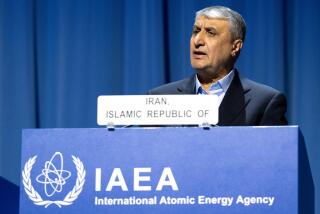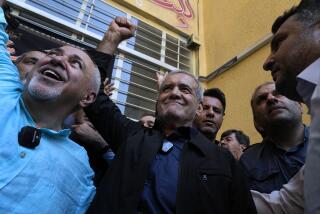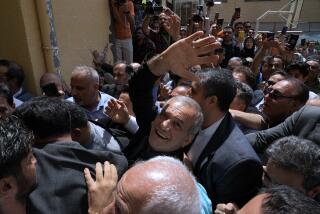Iran’s Conservatives Are Divided in Victory
- Share via
TEHRAN — After wresting control of parliament from reformists last week, Iranian conservatives sought Sunday to reassure the public that there would be no drastic restrictions of people’s freedoms.
Moderates such as Amir Mohebian, editor of Resalat newspaper, to hard-liners such as Hussein Shariatmadari, president of Kayhan publishing group, are voicing the same reassurances: People’s lives and freedom will not suddenly be constrained, economic reforms and privatization will be pursued, and Iran will seek closer relations with the West.
But hard-line and moderate forces within the nation’s conservative movement appeared to be heading for a showdown over what direction to take the Islamic republic.
Signs of a hard-line crackdown emerged in recent days: the closure of two reformist newspapers, the blocking of reformist Internet sites just before the election, the closure of an office belonging to the main pro-reform party and the issuing of court summonses to more than a dozen student activists.
The crackdown reflected differences between hard-line ideologues advocating a tough approach and moderate conservatives eager not to alienate people, especially with a presidential election due in two years.
With time, the differences between their approaches to economic, social and foreign policy are likely to become more pronounced.
After years of political infighting, war and revolution, Iranians crave a tranquil life. Conservatives campaigned on that sentiment in the recent election, accusing reformers of stirring up social tension for little or no gain. The conservatives, however, are unlikely to deliver the calm they have promised voters because of conflict in their own ranks.
In Friday’s vote, many Iranians stayed away in protest because 2,400 candidates, most of them reformists, were banned. But Iranians who refused to vote were as disenchanted with reformers as they were with the conservatives. They blamed reformers for failing to deliver promised change. Some who supported reformers in the past switched sides.
In all, 50.6% of eligible voters cast ballots, the lowest participation since Iran’s 1979 Islamic Revolution and a decline of 17 percentage points from the previous election. In Tehran, a stronghold of reformers, only 34% of eligible voters cast ballots. All of the 10 candidates announced as winners so far come from the main conservative party.
Poorer rural provinces recorded higher participation than the cities -- perhaps because of disenchantment with reformers or because lower education meant they were more likely to tune in to state radio and television, which aired a wave of appeals urging them to vote.
Having regained control of parliament, conservatives expect to win the presidency, which would give them control of the Cabinet. They could use their new parliamentary majority to impeach some of reformist President Mohammad Khatami’s ministers. So far, they say they intend to cooperate with Khatami for the remainder of his presidency.
The defining feature of Iran’s political landscape is its youthful population, with two-thirds under the age of 30. Conservatives must worry about the massive wave of young people flooding into the market, with unemployment at 14%, according to official figures. Unofficial estimates are higher.
It will be difficult for divided conservatives to satisfy young people disenchanted with reformists unable to deliver social change at a quicker pace. Reformists and conservatives know that if Iran’s youths took to the streets en masse, they could undo any regime.
Some conservatives believe that young people wouldn’t protest because they are tied up in their escapist, individualistic worlds. Conservative leaders also understand that suddenly imposing social regulations -- such as restricting the Internet too tightly or applying stricter Islamic dress codes to women -- could anger youths.
But as long as Iran’s young people remain alienated and unemployment remains high, the potential for civil strife exists. Student leaders and reformists warn that the spark that could ignite demonstrations or riots could be something small and unpredictable.
More to Read
Sign up for Essential California
The most important California stories and recommendations in your inbox every morning.
You may occasionally receive promotional content from the Los Angeles Times.













